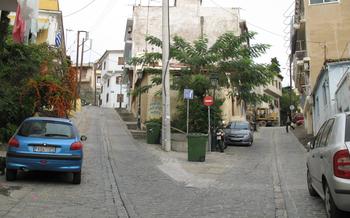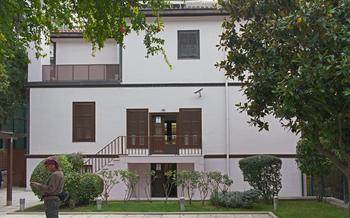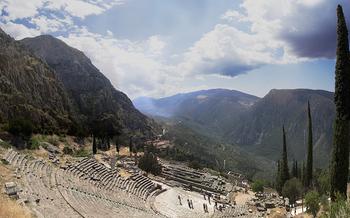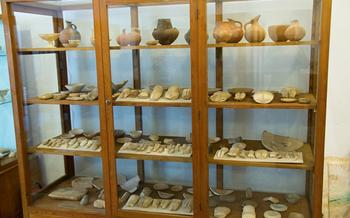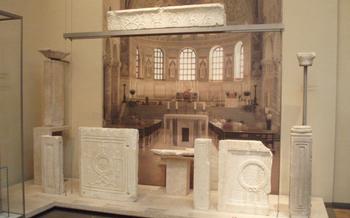
Museum of Ancient Greek, Byzantine, and Post Byzantine Musical Instruments
- The Museum of Ancient Greek, Byzantine, and Post Byzantine Musical Instruments
- Ancient Greek Instruments
- Byzantine Instruments
- Post-Byzantine Instruments
- Interactive Exhibits
- Guided Tours
- Museum Shop
- Educational Programs
- Temporary Exhibitions
- Concerts and Performances
- Research Library
- Accessibility
- Hours and Admission
- Location and Transportation
- Insider Tip: The Music and Archaeology Festival
The Museum of Ancient Greek, Byzantine, and Post Byzantine Musical Instruments
In the heart of Thessaloniki, where history intertwines with culture, stands a unique institution dedicated to preserving and showcasing the vibrant musical heritage of Greece. Established in 1997, the Museum of Ancient Greek, Byzantine, and Post Byzantine Musical Instruments is a treasure trove of musical artifacts, offering visitors a captivating journey through the evolution of Greek music across the ages.
Situated in the historic Villa Allatini, a stunning example of neoclassical architecture, the museum is easily accessible on Vasileos Irakleiou Avenue, a bustling thoroughfare lined with charming cafes, shops, and cultural attractions. Its elegant façade, adorned with intricate carvings and arched windows, hints at the rich collection housed within. Once inside, visitors are greeted by a welcoming atmosphere and a thoughtfully designed layout that guides them through the fascinating world of ancient Greek, Byzantine, and post-Byzantine music.
Ancient Greek Instruments
Ancient Greek instruments played a vital role in religious rituals, theatrical performances, and social gatherings. The most prominent types included:
- Stringed Instruments: The lyre, with its tortoise shell body and seven strings, was a versatile instrument used to accompany singing and poetry recitals. The kithara, a larger version of the lyre, was popular in classical and Hellenistic periods.
- Wind Instruments: The aulos, a double-reed instrument similar to an oboe, produced a piercing sound that could be heard over large distances. The syrinx, or panpipes, consisted of a set of graduated pipes bound together and played by blowing across the open ends.
- Percussion Instruments: The tympanum, a large frame drum, was used to mark the rhythm in religious ceremonies and dances. The sistrum, a crescent-shaped rattle with metal discs, was associated with the cult of the goddess Isis.
These instruments were crafted from a variety of materials, including wood, bone, ivory, and metal. The Greeks developed sophisticated techniques for playing their instruments, and their musical notation system, using letters and symbols, was one of the earliest known. Music was highly valued in ancient Greek society, and skilled musicians were held in high esteem.
Byzantine Instruments
The Byzantine era witnessed significant developments in musical instruments, influenced by the rise of Christianity and the flourishing of religious music. The church encouraged the creation of new instruments suitable for accompanying liturgical chants and hymns. This period saw the emergence of several distinctive instruments, including the kanonaki, a trapezoidal zither with 24 strings, played with a plectrum. The santouri, a hammered dulcimer with trapezoidal shape and metal strings, became popular in both religious and secular contexts. The oud, a short-necked lute with a rounded body and four strings, was adopted from the Middle East and became a staple of Byzantine music. Other instruments included the lyra, a bowed instrument with three strings, and the avlos, a double-reed instrument similar to the ancient Greek aulos. These instruments contributed to the development of a rich and diverse Byzantine musical tradition that would continue to influence music in the region for centuries to come.
Post-Byzantine Instruments
Post-Byzantine Greece witnessed the continuation of Byzantine musical traditions while also incorporating influences from the Ottoman Empire and Western Europe. This period saw the emergence of new instruments and genres, reflecting the diverse cultural landscape of the time.
Among the notable instruments that emerged during this period was the kanun, a plucked string instrument with a trapezoidal body and numerous strings. The oud, a short-necked lute, also gained popularity, becoming a staple of Greek folk music. The santouri, a hammered dulcimer with trapezoidal shape and numerous strings played with two small hammers, became another important instrument in this period.
In addition to these new instruments, the laouto, a long-necked lute, evolved from the Byzantine pandouri, taking on a more prominent role in Greek folk music. The clarinet, introduced during the Ottoman period, also became widely adopted, adding a new dimension to Greek musical expression.
These instruments played a crucial role in the development of Greek folk music and urban musical culture. They were used in a variety of genres, from traditional dances and songs to popular urban styles. The integration of Ottoman and Western influences enriched the Greek musical landscape, creating a unique and vibrant sound that continues to resonate today.
Interactive Exhibits
The Museum of Ancient Greek, Byzantine, and Post-Byzantine Musical Instruments offers a range of interactive exhibits that allow visitors to engage with the instruments and music of the past in a hands-on way. Visitors can play replicas of ancient instruments, such as the lyre, kithara, and aulos, and experiment with different playing techniques. Multimedia presentations and audiovisual displays provide insights into the history and significance of the instruments, while workshops and educational programs offer opportunities to learn more about Greek music and culture.
Guided Tours
The Museum of Ancient Greek, Byzantine, and Post-Byzantine Musical Instruments offers guided tours in multiple languages, providing visitors with an immersive and informative experience. Led by knowledgeable and passionate guides, these tours offer insights into the history and significance of the instruments on display.
Visitors can learn about the evolution of musical instruments from ancient Greece to the post-Byzantine era, the role they played in religious and secular contexts, and their impact on Greek culture and society. The guides provide detailed explanations of the construction, playing techniques, and musical notation of the instruments, making the exhibits come alive.
In addition to sharing their expertise, the guides also demonstrate playing techniques and perform musical pieces on replicas of ancient instruments. These demonstrations offer a unique opportunity to hear the sounds of these historical instruments and appreciate their musical qualities.
For those seeking a more personalized experience, the museum offers private guided tours tailored to specific interests and areas of study. Visitors can request specialized tours focusing on a particular period of music history, a specific instrument, or a particular theme related to Greek music.
Whether you are a music enthusiast, a history buff, or simply curious about the rich musical heritage of Greece, a guided tour of the Museum of Ancient Greek, Byzantine, and Post-Byzantine Musical Instruments is an unforgettable experience.
Museum Shop
The Museum of Ancient Greek, Byzantine, and Post-Byzantine Musical Instruments also features a well-stocked museum shop that offers a variety of souvenirs and merchandise related to Greek music and instruments. Visitors can purchase books, CDs, and DVDs on Greek music and instruments, as well as handmade replicas of ancient and traditional instruments. These replicas are not only visually stunning but also functional, allowing visitors to experience the sounds and feel of ancient musical instruments. The museum shop also offers a range of unique gifts and collectibles for music enthusiasts, such as jewelry, scarves, and home decor items inspired by Greek musical traditions. Whether you are looking for a special memento of your visit or a gift for a music lover, the museum shop has something for everyone.
Educational Programs
The Museum of Ancient Greek, Byzantine, and Post-Byzantine Musical Instruments offers a comprehensive range of educational programs designed to engage and inform visitors of all ages. These programs provide a unique opportunity to delve deeper into the fascinating world of Greek music and its rich history.
Workshops and seminars are regularly conducted by experts in the field, covering various aspects of ancient Greek, Byzantine, and post-Byzantine music. Participants can explore topics such as the construction and playing techniques of ancient instruments, the role of music in ancient Greek society and culture, and the evolution of musical traditions throughout the Byzantine and post-Byzantine periods.
The museum also collaborates with universities and music institutions to offer specialized courses and research opportunities for students and scholars. These programs provide hands-on experience with ancient instruments, access to rare and specialized resources, and the chance to work with leading experts in the field.
Whether you are a student, a researcher, or simply a music enthusiast, the educational programs at the Museum of Ancient Greek, Byzantine, and Post-Byzantine Musical Instruments offer an unparalleled opportunity to learn about and experience the rich musical heritage of Greece.
Temporary Exhibitions
The Museum of Ancient Greek, Byzantine, and Post-Byzantine Musical Instruments regularly hosts temporary exhibitions to showcase specific themes or periods of Greek music history. These exhibitions often feature rare and unique instruments, shedding light on the evolution and diversity of Greek musical traditions. Collaborations with other museums and cultural institutions bring new perspectives and insights to the museum's collection. Temporary exhibitions provide visitors with an opportunity to delve deeper into specific aspects of Greek music and explore the rich heritage of Greece's musical past.
Concerts and Performances
The Museum of Ancient Greek, Byzantine, and Post-Byzantine Musical Instruments is not only a place to learn about the history of music, but also to experience it firsthand. Throughout the year, the museum hosts a schedule of concerts and musical performances featuring renowned musicians and ensembles. These performances offer visitors the chance to hear ancient Greek, Byzantine, and post-Byzantine music brought to life in a historical setting, creating a truly immersive and unforgettable experience. Whether you're a music lover, a history buff, or simply looking for a unique cultural experience, attending a concert at the museum is a must. Check the museum's website for the latest schedule of performances and plan your visit accordingly.
Research Library
The museum also houses an extensive research library, a treasure trove of knowledge for music enthusiasts, scholars, and researchers. The library boasts an impressive collection of books, manuscripts, and documents, covering a wide range of topics related to Greek music history, organology, and performance practice. Here, visitors can delve into rare and specialized publications, gaining insights into the evolution of musical instruments, the development of musical genres, and the role of music in Greek society throughout the ages. The library is a haven for those seeking to explore the depths of Greek musical heritage, providing access to resources that are not easily found elsewhere.
Accessibility
The Museum of Ancient Greek, Byzantine, and Post-Byzantine Musical Instruments is committed to providing an accessible and inclusive environment for all visitors. Wheelchair users and visitors with limited mobility can easily navigate the museum's spacious galleries and exhibits through designated ramps and elevators. Audio guides and descriptive panels in multiple languages are available to assist visually impaired visitors in exploring the museum's collection. Multilingual signage and labels ensure that international visitors can understand the significance and history of the instruments on display. Family-friendly facilities, such as stroller parking and changing tables, make it easy for parents to enjoy the museum with their children. The museum also offers educational programs and activities tailored for children of all ages, fostering a love of music and appreciation for Greece's rich cultural heritage.
Hours and Admission
The Museum of Ancient Greek, Byzantine, and Post Byzantine Musical Instruments is open to the public from Tuesday to Sunday, with varying hours depending on the season. During the summer months (April to October), the museum is open from 8:30 am to 8:00 pm, while in the winter months (November to March), it is open from 8:30 am to 3:00 pm.
Admission fees are reasonable and vary depending on the visitor's status. Regular tickets cost 6 euros for adults, 3 euros for students and seniors, and 50 euros for children under 1Family tickets, which admit two adults and two children, are available for 15 euros.
To enhance the visitor experience, guided tours are offered in multiple languages for an additional fee. These tours provide a deeper understanding of the instruments' history, significance, and role in Greek culture.
For those interested in delving further into Greek music, the museum offers educational programs, workshops, and seminars throughout the year. These programs are led by experts in the field and provide a unique opportunity for hands-on learning and engagement with ancient and traditional instruments.
Location and Transportation
The Museum of Ancient Greek, Byzantine, and Post Byzantine Musical Instruments is conveniently located in the heart of Thessaloniki, Greece, at 28 Ethnikis Aminis Street. It is easily accessible by public transportation, with several bus stops and metro stations nearby. The closest metro station is Venizelou, which is just a short walk from the museum. If you prefer to drive, there are several parking garages and street parking options available in the vicinity. The museum's central location makes it an ideal starting point for exploring Thessaloniki's other cultural attractions, such as the White Tower, the Archaeological Museum, and the Museum of Byzantine Culture. Whether you choose to walk, cycle, or take public transportation, getting to the museum is a breeze, allowing you to seamlessly integrate your visit into your exploration of this vibrant city.
Insider Tip: The Music and Archaeology Festival
For an unforgettable experience, plan your visit to the Museum of Ancient Greek, Byzantine, and Post Byzantine Musical Instruments during the annual "Music and Archaeology Festival." This vibrant festival transforms the museum into a hub of musical activity, offering a unique opportunity to immerse yourself in the rich musical heritage of Greece.
Attend free concerts featuring renowned musicians and ensembles performing ancient Greek, Byzantine, and post-Byzantine music. Participate in hands-on workshops and guided tours led by experts in the field, gaining insights into the history, construction, and playing techniques of these fascinating instruments.
The festival provides a platform for cultural exchange and collaboration, showcasing the diverse musical traditions that have shaped Greece's musical identity. Embrace the spirit of the festival and let the enchanting sounds of ancient instruments transport you back in time, creating lasting memories that will resonate long after your visit.

